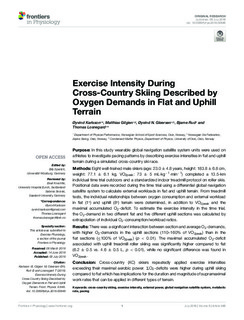Exercise intensity during cross-country skiing described by oxygen demands in flat and uphill terrain
Peer reviewed, Journal article
Published version
Permanent lenke
http://hdl.handle.net/11250/2579150Utgivelsesdato
2018Metadata
Vis full innførselSamlinger
- Artikler / Articles [2119]
- Publikasjoner fra Cristin [1107]
Sammendrag
Purpose: In this study wearable global navigation satellite system units were used on athletes to investigate pacing patterns by describing exercise intensities in flat and uphill terrain during a simulated cross-country ski race. Methods: Eight well-trained male skiers (age: 23.0 ± 4.8 years, height: 183.8 ± 6.8 cm, weight: 77.1 ± 6.1 kg, VO2peak: 73 ± 5 mL⋅kg-1⋅min-1) completed a 13.5-km individual time trial outdoors and a standardized indoor treadmill protocol on roller skis. Positional data were recorded during the time trial using a differential global navigation satellite system to calculate external workloads in flat and uphill terrain. From treadmill tests, the individual relationships between oxygen consumption and external workload in flat (1°) and uphill (8°) terrain were determined, in addition to VO2peak and the maximal accumulated O2-deficit. To estimate the exercise intensity in the time trial, the O2-demand in two different flat and five different uphill sections was calculated by extrapolation of individual O2-consumption/workload ratios. Results: There was a significant interaction between section and average O2-demands, with higher O2-demands in the uphill sections (110–160% of VO2peak) than in the flat sections (≤100% of VO2peak) (p < 0.01). The maximal accumulated O2-deficit associated with uphill treadmill roller skiing was significantly higher compared to flat (6.2 ± 0.5 vs. 4.6 ± 0.5 L, p < 0.01), while no significant difference was found in VO2peak. Conclusion: Cross-country (XC) skiers repeatedly applied exercise intensities exceeding their maximal aerobic power. ΣO2-deficits were higher during uphill skiing compared to flat which has implications for the duration and magnitude of supramaximal work rates that can be applied in different types of terrain.
